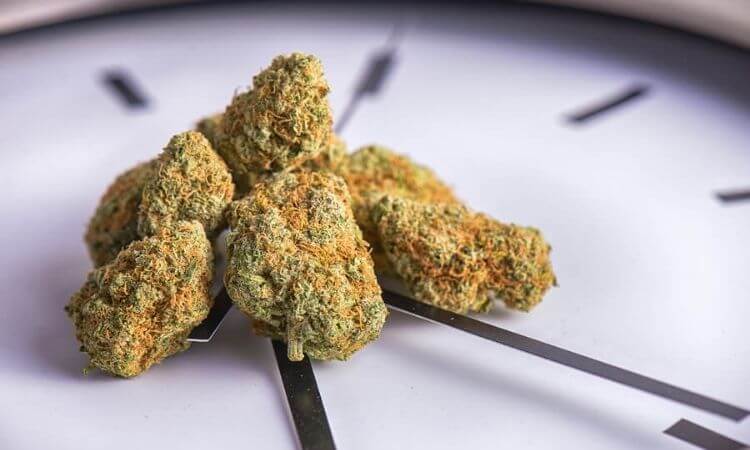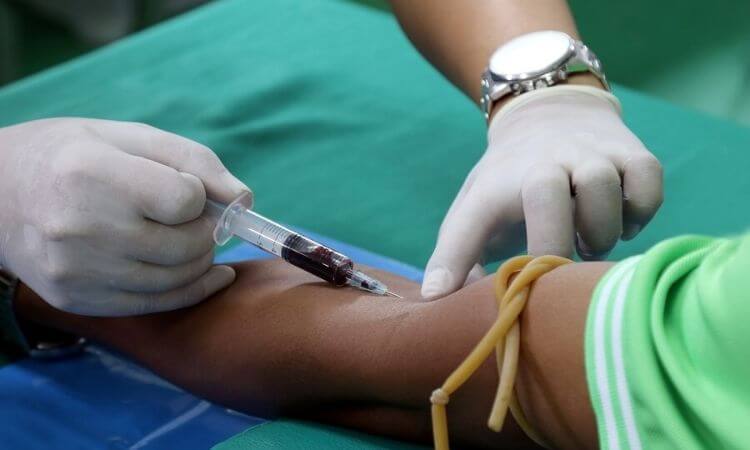
Marijuana, also known as cannabis, pot, and weed is detectable in bodily fluids for 1-30 days after last use. As with many other drugs, it may be identified in hair follicles for several months.
Marijuana detection windows depend on the amount ingested and how often. Naturally, higher doses and more daily use are associated with a more extended period of detection. In regular users, marijuana may be detected for many months after the last use.
Drug Test Detection Windows
Drug tests check for the presence of marijuana and its by-products, known as metabolites. These metabolites will stay in a person’s system long after the effects of marijuana have subsided. The detection window for these chemicals varies depending on the type of test used.
Urine Tests
According to the Mayo Clinic, marijuana can be identified in the urine for the following periods after last use:
- Occasional users (3 times per week or less): three days
- Moderate users (a few times per week): 5-7 days
- Chronic users (at least once a day): 10-15 days
- Heavy, chronic users (many times per day): over 30 days
Unlike some other water-soluble drug metabolites, cannabis metabolites attach to fat molecules in the body. As a result, it can take an extended period for them to leave a person’s system.
Blood Tests
Marijuana is typically detectable in the blood for 1-2 days. However, in some cases, it’s been detected for 25 days or longer. Chronic, excessive use extends the length of time that it can be identified.
Marijuana is detectable in the blood within seconds of inhalation. It’s distributed to the tissues, and some is reabsorbed in the blood and metabolized. The resulting metabolites may stay in the bloodstream for several days. For this reason, blood tests are used only to indicate recent marijuana use. Urine tests are more common, however, as they are less invasive.

Saliva testing
Marijuana is detectable in saliva for the following periods after last use:
- Occasional users: 1-3 days
- Chronic users: 1-29 days
Marijuana can enter the saliva via smoking or smoke exposure. Its metabolites, however, are only present in saliva when it has been smoked or ingested. In areas where cannabis has been legalized, saliva or mouth swab tests may be employed for roadside testing.
Hair Follicle Tests
Hair follicle tests evaluate drug use for up to three months. After use, weed reaches hair follicles through small blood vessels. Trace amounts may stay in the hair. Because hair grows, on average, about 0.5 inches per month, a 1.5-inch hair sample taken near to the scalp can provide a window of marijuana use for the past 90 days.
Metabolization Time and Factors That Affect It
THC, the psychoactive chemical in marijuana, is absorbed into the blood after entering the body. Some THC is stored in organs and fatty tissues. THC is then broken down in the liver, resulting in more than 80 metabolites.
The major marijuana metabolite that tests check for is known as tetrahydrocannabinol carboxylic acid (THC-COOH). It is inactive and highly fat-soluble. This metabolite, along with some others, remains in the body much longer than THC itself. Eventually, THC and its metabolites are expelled from the system via urine and feces.
Several factors may affect how long marijuana remains in a person’s system. These include age, sex, and body mass index (BMI). These aren’t associated with the drug’s use itself, but rather how each individual’s body processes and breaks it down.
Other factors are related to marijuana and how it is used. As noted, this includes how much is used and how often. Higher doses and more frequent use will likely extend the amount of time for marijuana to be cleared from a person’s system.
More powerful marijuana that is higher in THC may also remain in the body for longer. Likewise, marijuana ingested orally may stay in your system a bit longer than that which is smoked.
Unfortunately, there isn’t much a person can do to accelerate this process. Once in the blood, the body needs time to metabolize it and excrete it. Staying hydrated and exercising may help, but there is unlikely to be a dramatic difference in the timeline.
Of note, there are many marijuana detox kits available that usually required drinking a copious amount of water to dilute urine. They often include herbal or vitamin supplements, such as vitamin B12, to conceal the dilution. In general, these kits are not terribly reliable.
Time to Feel Effects
Marijuana’s effects may onset rapidly, often within 15-30 minutes after smoking. When consumed orally, it typically takes longer, perhaps even 1-2 hours after ingestion. The active ingredients in marijuana induce a brief “high.”
Common effects include the following:
- Euphoria
- Feelings of relaxation
- Slowed time perception
- Talkativeness
- Humorousness
- Altered sensory perceptions
Other short-term effects may include:
- Difficulty focusing
- Increased appetite
- Impaired coordination
- Drowsiness
- Restless
- Accelerated heart rate
- Confusion
- Anxiety
- Paranoia
- Dry mouth
- Low blood pressure, dizziness
- Feeling faint or fainting

In rare cases, high doses of marijuana can cause hallucinations and delusions. These reactions may also occur in certain individuals who are predisposed to them, such as those with schizophrenia.
Smoking or ingesting marijuana every day can have additional effects on the mind and body. People who do so may be at a heightened risk of cognitive, memory, and learning impairments.
They may also be more likely to experience heart disease, stroke, and respiratory problems such as lung infections or bronchitis. Mood disorders, such as anxiety or depression, may be more likely to occur.
If a woman uses marijuana when pregnant or breastfeeding, there’s an increased risk that the baby will have birth defects or issues with brain development.
Timeline for Effects
Marijuana’s acute effects start to subside after 1-3 hours. Some effects, such as memory problems or difficulty sleeping, can last several days.
Researchers aren’t sure how long the effects of chronic use can persist. Because the Drug Enforcement Agency continues to classify marijuana as a Schedule I substance, funding for research is scarce. However, it appears these effects may last days, weeks, or months after marijuana use has been terminated. Some consequences may be chronic or even permanent, in some cases.
Treatment for Marijuana Abuse
Marijuana is a drug with a high potential for abuse. Although it is a relatively mild substance in terms of effects, use can result in adverse health consequences. It can also affect performance at work or school, and will often cause conflict within relationships.
Marijuana’s ability to cause physical dependence may be still up for debate, but the truth is, it may be a tough habit to quit on your own. Chronic users do report withdrawal symptoms when they try to stop using. For this reason and others, professional treatment may be the best option for some people.
Midwood Addiction Treatment offers comprehensive programs intended to treat all aspects of drug abuse and mental health. Using a holistic approach, we provide clients with the tools and support they need to experience a full recovery.
Our services include those clinically proven to be beneficial in the treatment of addiction, such as the following:
- Cognitive-behavioral therapy
- Individual therapy
- Group therapy
- Peer support groups
- Medication-assisted treatment
- Health and wellness
- Substance abuse education
- Art and music therapy
- Aftercare planning
If you or someone you love is struggling to quit using marijuana or other substances, contact us today!